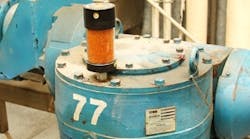Sponsored Recommendations
Sponsored Recommendations
April 14, 2025
April 14, 2025
April 14, 2025
Imagine a device attached to your personal vehicle that could extend a gallon of fuel by two or three times its normal use (or more). What if that same imaginary device could also reduce wear inside your engine, and what if you could extend the life of the engine years beyond what you would normally expect? If those were true, the decision to use this hypothetical device to enhance the driving experience and lower operating costs would be an easy one to make.
Unfortunately, no device making these specific claims for our personal vehicles currently exists. But what about other engines we use daily that drive industry, the engines that help millions of companies manufacture the goods and services that create our livelihood? What about a magic device for gearboxes?
In fact, there is a device that can extend the life and efficiency of gearboxes and the lubricants inside it. Called a desiccant breather, the device has proved effective in preventing atmospheric particulate and moisture from entering the gearbox.
As part of a lubrication excellence program, desiccant breathers can help extend the useful life of lubricants while eliminating the wear and tear caused by deteriorating fluid. Replacing an old-fashioned vent or breather cap with a desiccant breather is the most cost-effective method of protecting industrial equipment from atmospheric contaminants. Typical unavoidable contamination scenarios include thermal expansion and contraction, the filling or emptying of fluids, and temperature variations that cause condensation inside the equipment.
Companies are pressured to improve manufacturing efficiencies, lower costs, and improve their bottom line. Desiccant breathers have captured the attention of manufacturers' reliability experts as an economical way to help their employers achieve those goals.
Many machine failures are caused by contamination. A desiccant breather placed on equipment and replacing the existing air vent can become the first line of defense in contamination control.
Particle and water ingression tests prove that ISO contamination levels drop substantially with use of a desiccant breather, producing cleaner oils, fluids, and fuels. The life of a lubricant can typically be proved to more than double. The return on investment (ROI) is easily measured using these results. Previous maintenance expense histories can be used to determine additional savings. ROI measurements include reductions in fluid replacement, disposal costs, and labor associated with handling the fluid. Less downtime—the result of fewer equipment failures and replacements thanks to less contamination and deterioration—can mean additional cost savings.
Since the desiccant breather’s introduction more than 25 years ago, necessity and innovation have forced breather manufacturers to improve their products. Today’s advanced desiccant breather technology maintains a small footprint yet lengthens the effective life of the breather courtesy of a design that isolates the desiccant—an isolation valve. Isolation valve technology separates the media from pressurized air exhausted from the gearbox and lengthens desiccant life by keeping moisture from the gearbox headspace at bay. This technology also protects the desiccant from oil and/or fume contamination typically generated by the fluids inside the gearbox. In older breathers, oils and fumes were capable of seeping into the desiccant media in some applications, restricting the path of air flow and rendering the breather ineffective.
In the past, most gearboxes used a chrome vent cap filter. This type of breather filter did not capture moisture and only captured particles of 10 to 40 microns. Today’s desiccant breather filtration varies from 1 to 3 microns in size, depending upon the manufacturer. Please note that Beta or Absolute ratings are specific only to fluid filtration and are not a scientific measure of air filtration as performed by the particle filters in the desiccant breather. The only government-certified air filtration available is HEPA. The HEPA stamp ensures particle filtration down to 0.3 microns—less than one-third of one micron.
Joe Loftin is Director of Sales at Whitmore and has more than 30 years’ experience consulting industrial manufacturing facilities, specializing in automation and best practices. He is certified through the International Council for Machinery Lubrication, MLTI-004590. Contact Joe at [email protected].
When selecting a desiccant breather for any application, calculating the cubic-feet-per-minute (CFM) requirement is vital. Air exchange requirements are stipulated by thermal expansion or by contraction during the filling and emptying process. The demand for air flow through a breather should not exceed a breather’s air-handling capacity. The CFM requirement is especially important for hydraulic reservoirs or fuel tanks where liquid levels may rise and fall significantly during operations or filling and emptying process. Gearboxes typically experience thermal expansion and contraction (which is usually minimal), and low-CFM-rated breathers work fine.
Improving equipment efficiencies and a reduction in overall operational cost are great places to start when considering establishing and maintaining a lubrication excellence program. These methods reduce the cost of operation while increasing net profits and earnings per share. The desiccant breather may be considered “a magic device” by some, but during the past 25 years, its effectiveness has proved to be one of the fundamental building blocks upon which successful lubrication management programs work.
